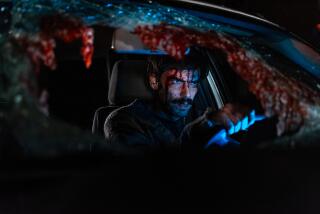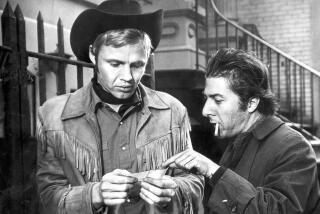Some can’t stomach this film
- Share via
Thousands of Southern Californians were no doubt clutching their seats while watching “Cloverfield,” last weekend’s No. 1 movie at the box office. At least a few of them were clutching their stomachs as well.
Since the movie opened last Friday, some patrons said they experienced nausea and dizziness while watching the horror flick, much of which was filmed with a herky-jerky, hand-held cameras.
Erika Hasegawa, 32, was watching “Cloverfield” at a theater in Alhambra on Tuesday night but had to leave in the middle of the film.
“I’m really nauseous right now -- just hold on for a second,” she said, before walking down the hall and retching into a trash can.
“I wish I could get my money back,” she said.
It is unclear how many people felt ill while watching the movie, which follows a group of young hipsters filming themselves with a camcorder as they flee a reptilian monster that is destroying New York City. The movie set box office records on its holiday weekend opening, earning about $46 million.
Reports of illness while watching “Cloverfield” popped up on Internet bulletin boards over the weekend, with some posters writing that they had to leave a few minutes into the movie. Others said they tried to stare at a wall as the movie continued. One Internet poster reported vomiting several times.
A call to Paramount Pictures, which released the movie, was not returned.
Executives at some movie chains stressed that the vast majority of viewers felt fine.
Nonetheless, AMC Theatres, which is based in Kansas City, Mo., placed caution signs in hundreds of its theaters nationwide warning about possible motion sickness.
Mann Theatres Chief Executive Peter Dobson said there were three reports of illness at Mann theaters in Los Angeles over the weekend and one in Glendale.
“I must confess I was a little surprised, but sometimes from time to time this happens,” Dobson said. “It’s not normal to get four in a weekend.”
Some experts were not surprised, given the film’s use of hand-held cameras that were shaken to boost suspense.
It is a technique that has been used in other movies -- notably the “Blair Witch Project,” a 1999 film that also prompted viewer complaints about nausea and vomiting. It also involved young adults filming themselves with camcorders while trying to escape a mysterious, terrifying force.
The problem may be more pronounced at theaters with bigger screens. The larger the screen, the harder for the viewer to keep a visual frame of reference, said John Risey, an audiologist at the Ochsner Clinic in New Orleans.
“To your brain, it does appear that the entire world is moving,” Risey said.
That’s not an issue when viewing the same film on a small TV screen, he said.
“What makes you dizzy is that the visual environment is moving beside you and yet you are still,” Risey said.
The brain becomes confused, he said, and can trigger reactions in other parts of the brain that cause nausea and vomiting.
What the eyes process visually has enormous effect on how the body reacts, said Dr. Dennis Maceri, an associate professor at the USC School of Medicine who specializes in ear, nose and throat care. The body reacts to what is seen, he said, even if it’s not real.
In the 1968 Steve McQueen movie “Bullitt,” viewers watch a car chase on the steep hills of San Francisco.
“He goes down the big hill, and you can feel your stomach move . . . even though your body is stationary,” Maceri said.
“The eyes can fool you,” he said.
Some people experience a similar feeling as they read in a moving car, he said. To the eyes, the words appear to jump around and “you can’t stabilize your gaze.”
Experts suggest that those who feel motion sickness should stare at a fixed point that appears not to move, such as the head of someone in the theater, Risey said.
Dramamine, an anti-motion-sickness medication, also might help, he said.
Peter Bohlen, an 18-year-old high school student from Glendale, said he was nauseated after watching the movie Saturday with four friends, and still wasn’t feeling well a day later.
“They’re trying to go for the home video feel, so it’s constantly shaking around,” Bohlen said. “My brain tried to make it work, but it couldn’t. I got a pretty heinous headache afterward.”
Roxanne Garrett, 18, of Alhambra said she was feeling dizzy at first.
“But I got used to it,” she said.
Scott Correll, 38, of South Pasadena said the jerky motion of the camera is a filming style that has become popular in recent years.
“It’s stimulus overload, and you get used to it,” Correll said. “It’s the way everything is these days.”
Dobson, the chief executive of Mann Theatres, said he believed that the vast majority of viewers felt fine.
“We’ve shown it to thousands of people this weekend, so the actual percentage of people [who felt ill] is really low,” Dobson said. “We’re delighted with the business ‘Cloverfield’ is doing.”
--
More to Read
The biggest entertainment stories
Get our big stories about Hollywood, film, television, music, arts, culture and more right in your inbox as soon as they publish.
You may occasionally receive promotional content from the Los Angeles Times.











